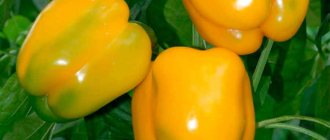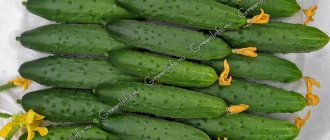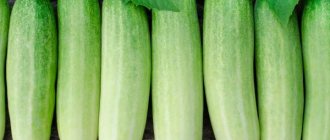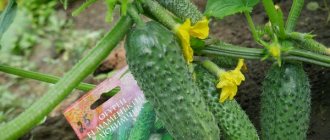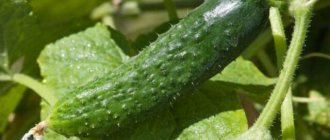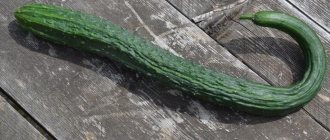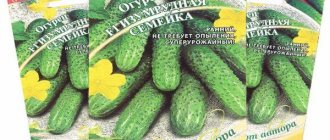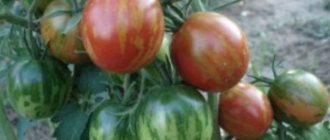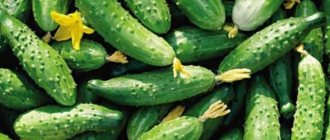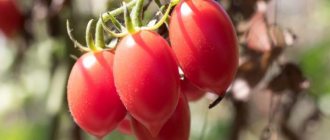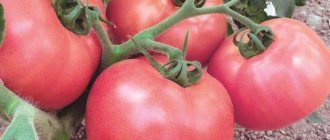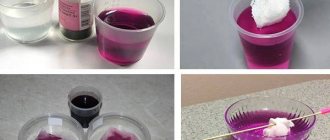The real man F1 delights farmers thanks to its presentable appearance, amazing taste and high marketability of greens. The cultivar is famous for its large-scale harvests and friendly fruiting.
| Landing location | Ripening time | Mode of application | Fruit length | Group | Fruit smoothness | Pollination method |
| Universal | Mid-early (46-55 days) | Salad | Very long - more than 20 cm | Hybrid | Highly lumpy | Bee pollinated |
Characteristics and description of the variety
The hybrid "Real Man" was produced by Russian breeders working in... Included in the State Register of the Russian Federation in 2010. It is classified as a table variety for salad purposes. These cucumbers are suitable for canning only in sliced form. The hybrid adapts well to external conditions: low light, high humidity, temperature fluctuations.
The variety received such an interesting name because of its characteristics: the bushes are shade-tolerant, resistant to most pests and diseases, the fruits look strong and are covered with sharp thorns. It has strong immunity to major diseases and parasites, in particular to mosaic, spotting, and powdery mildew. Susceptible to infection with peronosporosis. The described plant is pollinated by insects. The Real Man cucumber can be grown in open beds and in protected soil in unheated conditions. The recommended cultivation method is using a trellis or net.
Did you know? The longest cucumbers in the world—1.5–1.8 m each—are produced by the Chinese species. In Asian countries they are cultivated on the roofs of houses.
Features of the bush and fruits
The cucumber bushes of the described hybrid grow tall. They have many large dark green leaves. Flowering is mainly of the female type. From 1 to 3 nodes are formed on one node. The fruits are elongated, with many large tubercles.
The average weight of one cucumber reaches 300-400 g, length - 25-40 cm. The skin of the fruit is dark green with short white stripes, pubescent, with white prickly spines. The pulp is characterized by strength, juiciness, and sweet taste. There are no voids in it. There are very few seeds.
Fruitfulness
The productivity of the variety is good. On average, about 10 kg of fruits are harvested from 1 m².
Did you know? Scientists believe that cucumber began to be cultivated 6 thousand years ago in the territory of modern India. Wild cucumbers are found today at the foot of the Himalayas.
Flowering and ripening times
Flowering occurs about a month after the first shoots emerge. The hybrid is characterized by early ripening - 48–54 days pass from the appearance of sprouts to harvest. Fruiting is long - lasts about three months.
Description of the hybrid
The cucumber hybrid Real Man F1 is recommended for cultivation in the European part of Russia , both in open and closed ground. Refers to mid-early. Requires pollination by insects.
Distinctive features
Distinctive features of the hybrid: A real man:
- shade tolerance uncharacteristic for cucumbers (gives a good harvest in the shade);
- resistance to cool and cloudy weather.
Another feature is the size of the fruit . Their average length is 30-35 cm, while they are narrow and prickly.
Composition properties, benefits, calorie content
In summer, cucumbers are the most common vegetable on our menu. It consists of 95% water, but at the same time it has a fairly rich and healthy composition:
- vitamins B1, B2, B9, C, H, PP, E, A;
- magnesium, iodine, phosphorus, potassium, calcium;
- alimentary fiber;
- essential oils.
Cucumbers are rightly called a low-calorie dietary product. They contain only 14 kcal per 100 g.
Useful qualities of cucumbers:
- removal of waste and toxins from the body, which is especially important for residents of megacities;
- getting rid of radionuclides - useful for those who have been exposed to radiation;
- supporting heart function, strengthening blood vessels, normalizing blood pressure;
- prevention of thrombosis;
- regulation of the gastrointestinal tract - acceleration of metabolism, cleansing of the intestines;
- strengthening the immune system;
- normalization of the endocrine system, in particular the thyroid gland;
- support the nervous system, protection from stress;
- moisturizing, skin whitening;
- fight against excess weight.
Despite the obvious benefits, it is recommended to consume no more than 1.5 kg of cucumbers per day and not at one time.
Other long-fruited cucumbers:
Caring for cucumbers Chinese miracle for a rich harvest
Hybrid cucumber “Chinese cold-resistant f1”
How to grow long Chinese Snake cucumbers
Characteristics
The bush is long, climbing, with large dark green leaves . From one to three ovaries are formed in one node. It is better to place the hybrid vertically on trellises or netting to obtain straight fruits.
Cucumbers are long, up to 40 cm, weighing 300-400 g . They are smooth and narrow at the base, pimply and prickly in the middle. Therefore, they harvest with gloves. The pulp is juicy and dense, containing almost no ripe seeds.
8-10 kg are collected from one square meter . A mid-early hybrid allows you to harvest all summer. Cucumbers with a pronounced taste and aroma are intended for salads, but are also suitable for pickles when sliced.
Cucumber Real Man. SeDeK
Sowing technology
Cucumbers are planted in two ways. In the first case, seedlings are first grown indoors and then moved to an open garden bed. After such planting, cucumbers bear fruit earlier. With the seedless method, seeds are directly sown in open ground. Let us dwell on the details of the last method, applicable in regions with warm climates.
For sowing cucumbers, it is necessary to select an area that is well lit and warmed by the rays of the sun, and protected from drafts. The recommended location of the beds for proper lighting and friendly fruiting is from north to south. When growing cucumbers, it is important to adhere to the rules of crop rotation.
According to them, this crop needs to be planted in beds where the following previously grew:
- cabbage;
- salad;
- potato;
- tomatoes.
Important! There is no need to rush into sowing cucumbers. If a heat-loving plant is exposed to cold temperatures or even frost, it will stop growing and may die.
The risk of developing diseases and pest attacks, as well as reducing yield, increases if the plant is planted after:
- cucumbers;
- carrots;
- zucchini;
- melon crops.
Cucumbers grow well in fertilized light and loose soil that has neutral acidity.
Before sowing, the area must be prepared. This is done in 2 stages: autumn and spring. In autumn, the area is cleared of plant debris and dug well. Then they dig a trench to a depth of 20–25 cm and a width of 70 cm. In its center, a ditch 30–35 cm deep is made, into which leaves, peat, sawdust, straw, and grass are placed in a layer 15 cm high. Fresh manure is placed in the next layer. In the spring, a layer of soil fertilized with minerals is placed on it. Then the bed is covered with film on the arcs in order to warm it up.
Find out more about planting cucumbers in open ground.
If autumn preparation has not been carried out, then in the spring, 2-3 weeks before planting, rotted manure, mullein, chicken droppings or compost with wood ash and nitrophoska are added to the site. To warm up, the bed is also covered with film.
Since Real Man is a hybrid, its seeds can only be purchased in a specialized store. Those collected with your own hands or purchased second-hand are not suitable for planting, since they do not retain the qualities of the mother plant.
The purchased seeds do not need to be treated or soaked; the manufacturer has already taken care of this. Sowing should be carried out from the last ten days of May to the first ten days of June (depending on the region and climatic conditions). The earth at a depth of 12 cm should already warm up to +15°C at this time, and the air during the day should warm up to +18... +26°C. The procedure is planned for a calm, sunny day. Before the procedure, the prepared furrow is watered generously.
Planting seeds in open ground:
- Sowing is done in previously prepared and fertilized soil. This is done after the threat of frost has been eliminated.
- 4-6 seeds are placed in each furrow at a distance of 7-10 cm. They are sprinkled with earth on top. Leave 50-70 cm between furrows.
- Before germination, the soil is moistened, but not flooded.
- Shoots appear in seven to 14 days.
- Then they are thinned out, leaving 3-4 of the strongest shoots in the furrow.
Video: planting cucumber seeds in open ground
We grow seedlings:
- We fill the pots with disinfected soil (potassium permanganate or in the oven), peat ones work well.
- Sow 1-3 seeds in each to a depth of 1-1.5 cm.
- Before sprouting, we moisten the soil well. We maintain the temperature +21°C. The Real Man's germination rate is approximately 70%.
- If these conditions are met, sprouts will appear in 1-2 weeks. Shoots need full lighting.
- Do not overuse fertilizers. When the plants grow to the first two leaves, they are picked and left one at a time in the pot.
- Before transplanting seedlings into open ground, they are taken outside for hardening. Until acclimatization is complete, she should avoid direct sunlight, cold and wind.
Benefits of cucumber for children
Cucumber has long become a familiar vegetable to us. Its benefits and harms for a child’s body are just as invaluable as for an adult.
1. Regularly eating green vegetables will allow the child’s body to avoid developing silicon deficiency. Also, the child does not risk suffering from anemia.
2. Cucumbers contain iodine. Therefore, the vegetable prevents the development of pathologies associated with the endocrine system.
3. Fresh cucumbers are rich in potassium, their benefits and harms are obvious (valuable properties predominate). Thanks to potassium, the baby develops a stable psyche. The nervous system is fully strengthened.
4. The vegetable has a beneficial effect on digestion and all metabolic processes. The child’s immune system is strengthened, but cucumber should be given no earlier than 1 year.
Plant care
Ventilation of plantings begins from the moment shoots emerge. The film is opened slightly every day, giving an influx of fresh air. It is completely removed when the first flowers form. Further care consists of regular watering, fertilizing, loosening, weeding, gartering and preventive spraying.
Important! Watering cucumbers is done with water at a temperature not lower than +18°C. Humidification with cold water leads to improper plant development and increases the risk of fungal diseases.
Watering and fertilizing
Cucumbers are moisture-loving plants. In case of moisture deficiency, they become brittle, and the fruits are less juicy and small. But at the same time, the plant also does not tolerate waterlogging, which leads to lightening of the foliage, stopping the growth of vines and reducing productivity. When watering, it is important not only to establish the optimal frequency and volume, but also to achieve regularity. If plants grow under conditions of changes in moisture, the fruits may be bitter.
Before flowering, it is recommended to carry out one moistening every 5–7 days, using 3–6 liters of water per 1 m². During fruiting, watering is increased to once every 2-3 days. The volume of liquid is increased to 6–12 liters. Moisturizing is done with a watering can in the evening or early morning. When carrying out the procedure, you need to ensure that moisture does not get on the ground organs of the plant.
Hermaphroditic flowering type
A cucumber flower can combine male and female genders
Hermaphroditic species are male and female cucumber flowers in one inflorescence. It is characterized by short ovaries. From such an ovary, most often, cucumbers appear, presented in a spherical shape. The description points to the fact that the hermaphrodite contains both pistils and stamens. Such inflorescences can be either self-pollinating or pollinated by insects. Same-sex flowers can also be my characteristics.
- Andromonocytic type. It includes bisexual features, where the male type predominates.
- Gynomonocytic type. Characterized by the fact that it contains hermaphroditic tendencies, mostly female in structure.
The main feature of this type is that its flowers are bisexual. Some experts confidently convince farmers that the first varieties of cucumbers were hermaphrodites. It was from them that the division into female and male types of flowering began to occur. Most people try not to use plants of this type to grow for sale. Such plants have gained great popularity only among breeders who are trying to create new varieties of cucumbers.
Disease and pest control
As already noted, the hybrid Real Man has strong immunity to many diseases, but weakly resists peronospora or downy mildew. The main symptom of infection is oily spots on the leaves. To prevent this disease in the garden, it is necessary to disinfect the soil before planting with potassium permanganate (1%) and copper sulfate (3%). The drugs “Acrobat MC” (50 g/10 l of water), “Alirin B” (2 tablets/10 l), “Oxychom” (15 g/5 l), “Quadris” (0.2%, 0) are effective for treatment. ,1%).
Among the pests that pose a danger to cucumbers are:
- Sprout fly. The larvae of this insect cause enormous damage to seeds and young plants. To get rid of it, you need to treat it with insecticides “Zenkor”, “Hurricane Forte”, “Iskra”, which is carried out 3 times.
- Spider mite. This insect attacks cucumbers when it is hot and dry outside. Its presence is indicated by cobwebs on the vines and foliage. There are small holes on the top leaf plate. Soon the leaves dry out. Fundazol, Fitoverm, Bitoxibacillin, Actofit, Fufanon, and colloidal sulfur are used against ticks.
- Aphid. Symptoms of infection: curling of leaves, falling of flowers and foliage. If the number of insects is small, treat with a soap solution, sprinkle the beds with wood ash, or an ash-tobacco mixture. In case of severe infection, they resort to the use of the drugs “Inta-Vir” and “Decis”.
- Thrips. These small insects settle on leaves and drink plant sap. As a result, you can see small punctures on them. With minor damage, treatment with folk remedies, for example, infusion of onion peels, helps. In case of mass damage, spraying with “chemistry” is necessary: “Fufanon”, “Fitoverm”, “Iskra M”, “Commander Maxi”.
- Nematode. Small worms, called nematodes, live underground and infect the root system, leading to the appearance of growths on the roots, improper development of the plant, and a decrease in the quality and volume of the harvest. Cucumbers look depressed, their leaves are twisted. If the damage is severe, the plant will need to be disposed of. If infection is detected in a timely manner, when the roots are not severely damaged, treatments with Mercaptophos, Phosfamide, and BI-58 will help.
How to prepare the soil?
After harvesting, the area for cucumbers is cleared of old vegetation and weeds. Usually the bed is dug up in the fall, but it is recommended to first treat the soil with copper sulfate or Bordeaux mixture, 2 l/m2.
More on the topic: What kind of care does the Rodnichok cucumber require?
These products have antiseptic characteristics, prevent the development of fungus and pathogenic bacteria, and are harmful to insects.
The bed is improved, humus is added, 10-20 kg/m2. Throughout the growing season, cucumbers consume a lot of nutrients from the soil. The chemical composition must be restored. In autumn, apply manure, 1 kg/m2 or peat 5 kg/m2. Ash is introduced as a mineral fertilizer and fungicide, up to 500 g/m2.
With cold weather, insects climb into the ground; fall into suspended animation. In spring they come to the surface and parasitize plants. To prevent the emergence of garden pests, the area is sprayed with the pesticide “Prestige”, “Fufanon” or “Nitrophoska”, “Azofoska” is applied.
To restore the mineral composition of the soil, fertilizers are introduced. Use potassium salt, superphosphate, ammonium nitrate. Some plant growers irrigate the soil with “Potassium Humates” or the “Baikal” preparation.
Folk remedies include a mixture of crushed eggshells and pine needles. The shell contains a lot of calcium, potassium, phosphorus, sodium and other chemical elements.
The needles are distinguished not only by their rich mineral composition, but also by their antiseptic properties. The smell of pine needles repels insects.
To improve the soil structure and normalize acidity, biofertilizers are introduced: “Shine-1”, “Gift of Fertility”, “Weaving of Chernozem”. Bacteria promote better rotting of vegetation residues and weed seeds.
When using biofertilizers, you can apply manure that is not fully mature. In the fall, the area is dug up without destroying the lumps.
Harvest and storage
During the period of mass fruiting, you should inspect the beds and remove ripe fruits 2 times a day (morning and evening). If you plan to eat them fresh, then it is important to avoid overripening, when the cucumbers turn yellow, become coarse and lose their crispness.
Important! When picking cucumbers, a real man should protect his hands with gloves so as not to get hurt by the thorns.
The greens must be removed from the vines by twisting or cutting with pruning shears. The stalks should remain on the vines. Cucumbers should not be pulled or pulled to avoid damaging the plants. Also, do not disturb the leaves and lashes. Not only ripe fruits should be removed from the vines, but also those that are damaged or deformed. This is necessary so that they do not weaken the plants. This will stimulate the production of new greens.
After harvesting, the fruits should be immediately placed in a cool place. In cold and humid conditions, at a temperature of +6...+8°C and a humidity of 85–95%, they can be stored for 1-2 weeks. They should be placed in a bag without closing and placed in a vegetable tray in the refrigerator. Storage in a cellar, in wooden boxes or trays is also possible. At room temperature, after two days, cucumbers lose their taste and a large number of valuable elements. To preserve them for the winter, they need to be salted, preserved or frozen.
Did you know? In our latitudes, it is customary to eat cucumber as a vegetable, in salads or as a whole. However, there are countries where it is eaten as a dessert. For example, residents of Morocco put it on the sweet table, along with fruits, berries and sweets.
To summarize, we note that the Real Man cucumber hybrid can be considered for planting in a summer cottage, since it has a number of advantages, such as tasty fruits, good fertility, and resistance to most diseases. With proper agricultural technology, the plant will delight you with an early and high-quality harvest.
Characteristic differences of the variety
“Real Man F1” is a hybrid of medium and early maturation. This connection allows you to harvest almost all summer. The main thing is to choose the right seeds, process them and carry out all care measures.
- cultivation is possible in open areas and in greenhouses;
- the appearance of fruits begins on the 48th day;
- large strong leaves;
- nodular formation of the ovaries.
Appearance of fruits:
- cylindrical shape;
- elongated (30-40 cm in length), narrow in diameter greens (see photo);
- narrowed upper part without spikes and bumps;
- on the main surface there are large tubercles with small spines.
Advice: It is better to wear gloves when picking fruits, so as not to injure your hands on the prickly thorns.
Cucumbers are developed as a salad variety, but they are also used in canning. The pulp is dense, crispy, with a small amount of seeds. “A real man” is not afraid of cloudy, non-sunny days and tolerates shade well.
If you follow all the care rules, the harvest will last more than 3 months.
Harm of cucumber
Cucumber has both benefits and harm to the body. Positive qualities clearly prevail over negative ones.
Let's figure out when a vegetable can cause harm:
- individual intolerance;
- peptic ulcer;
- diarrhea.
Cucumbers are endowed with enormous benefits. As for the harm, it is minimal. Remember that you should not overuse the fruits. Otherwise, you may encounter unpleasant consequences in the form of diarrhea.
17:14
Appearing in Russia back in the 9th century, the cucumber immediately took pride of place on the dinner table. Few vegetables can compare with cucumber in popularity! But this wonderful fruit with an emerald crust is valued not only for its wonderful aroma and taste. Cucumber also has a lot of useful properties, thanks to which it has become an indispensable product.
Let's figure out what health benefits come from fresh and other cucumbers, whether they can cause harm to the human body, find out all their beneficial, medicinal and harmful properties, and tell you about existing contraindications.
Vegetables to improve erection: is it worth eating?
A good erection depends on many components, the most important of which is a properly selected diet. Poor nutrition negatively affects metabolic processes and increases cholesterol levels. In turn, this affects the functioning of all body systems, including reproductive.
A man's food, first of all, should be varied, include proteins of animal and plant origin, essential microelements and vitamins. Vegetarian food is an important component of such a diet, so it is imperative that the daily menu includes vegetables that have a positive effect on libido and erection.
Remember that positive effects can be combined with negative effects on the body. Before choosing a particular dish as an aphrodisiac, it is recommended that you familiarize yourself with the contraindications and side effects. Vegetables that are good for potency should not cause harm to other organs and systems of the body.
